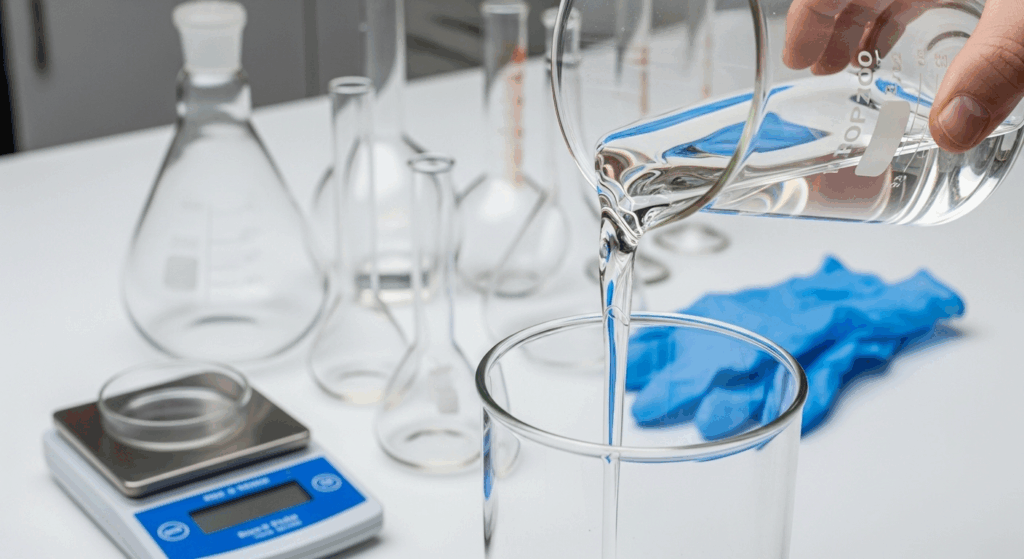DINP and DOP are both plasticizers that make plastic flexible, but DINP is the safer, modern alternative that’s replacing DOP in most products due to health concerns. While DOP has been the go-to plasticizer for decades, it’s now restricted in many countries because it can disrupt hormones, whereas DINP has a better safety profile and meets stricter regulations.
The key difference comes down to safety and performance. DINP molecules are slightly larger, which means they don’t leak out of plastic as easily as DOP does. This makes DINP products last longer and pose fewer health risks, especially in toys and medical devices.

What is DOP
DOP (Di-Octyl Phthalate), also called DEHP, is a chemical compound that makes hard plastics like PVC soft and flexible. It’s been the world’s most popular plasticizer since the 1950s, turning rigid plastic pipes into bendable garden hoses, soft medical tubing, and flexible vinyl flooring.
The problem with DOP is that it doesn’t chemically bond to the plastic. It can slowly leak out over time, especially when the plastic is heated or comes in contact with oils or fats. This is why old vinyl car dashboards get brittle and crack – the DOP has escaped.
More concerning is what happens when DOP enters our bodies. Studies show it can interfere with hormone production, particularly affecting testosterone and reproductive health. Children are especially vulnerable, which is why DOP has been banned in children’s toys in the EU, US, and many other countries since 2009.
What is DINP
DINP (Diisononyl Phthalate) is a newer generation plasticizer designed to replace DOP with better safety and performance characteristics. It does the same job – making plastics flexible – but with a molecular structure that makes it less likely to cause health problems.
The DINP molecule is larger and has more branches than DOP. Picture it like the difference between a straight key and one with lots of teeth – the more complex shape makes it harder for DINP to escape from the plastic matrix. This means products made with DINP stay flexible longer and release fewer chemicals into the environment.
DINP excels in applications where safety matters most. It’s now the standard plasticizer for children’s toys, medical devices that don’t directly contact blood, and food packaging materials. While it still belongs to the phthalate family, extensive testing shows it doesn’t cause the same hormonal disruptions as DOP.
The switch to DINP isn’t just about safety. It actually performs better in many applications, offering improved resistance to extraction by water and better stability at high temperatures. This makes it ideal for outdoor products like garden furniture and car interiors that face harsh conditions.
Manufacturers have embraced DINP because it requires minimal changes to existing production processes. You can essentially swap DOP for DINP in most recipes without major equipment modifications, making the transition economically feasible.
The Difference Between DINP and DOP
Comparison Table
| Property | DOP (DEHP) | DINP |
|---|---|---|
| Chemical Formula / Structure | C₂₄H₃₈O₄ – Linear structure with two straight octyl chains | C₂₆H₄₂O₄ – Branched structure with isononyl chains |
| Physical Properties | Clear, oily liquid; Density: 0.98 g/cm³; Boiling point: 385°C | Clear to pale yellow liquid; Density: 0.97 g/cm³; Boiling point: 403°C |
| Plasticizing Efficiency | Excellent – requires 40-50 parts per 100 resin | Good – requires 45-55 parts per 100 resin |
| Flexibility | Superior at low temperatures (-30°C); Maintains flexibility well | Good at low temperatures (-25°C); Slightly stiffer than DOP |
| Volatility | Higher – migrates easily from plastic; Loss rate: 2-3% per year | Lower – better retention; Loss rate: 1-2% per year |
| Common Applications | Legacy medical devices, industrial flooring, wire coatings (restricted use) | Toys, food packaging, modern medical devices, automotive interiors |
| Health Hazards | Endocrine disruptor; Reproductive toxicity; Possible carcinogen; Liver damage | Lower toxicity; No reproductive effects at normal exposure; Minimal endocrine activity |
| Environmental Impact | Bioaccumulates; Persistent in environment; Toxic to aquatic life | Less bioaccumulation; Faster biodegradation; Lower aquatic toxicity |
| Safe Daily Intake (EU) | 0.05 mg/kg body weight/day | 0.15 mg/kg body weight/day |